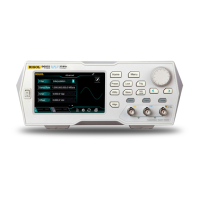RIGOL Chapter 2 Performance Verification Test
DG800 Performance Verification Guide
Spurious Signal Test
Specification
Sine Wave Spectrum Purity
Spurious signal
(non-harmonic)
≤10 MHz: <-60 dBc
>10 MHz: <-60 dBc + 6 dB/octave
[2]
Note
[1]
: 0 dBm output, DC offset 0, impedance 50 Ω.
Note
[1]
: 6 dBc/octave means that when the frequency doubles, the specification increases by 6 dBc. For example,
when the output frequency of DG800 is 10MHz, the specification is <-60dBc and when the output frequency
is 30MHz, the specification is <-60dBc+2×6dBc, namely <-48dBc.
Test Procedures
1. Make sure that the environment temperature is between 18℃ and 28℃ and
DG800 has been warmed up for at least 30 minutes. Connect the channel output
terminal (take CH1 as an example; the test method is also applicable to CH2) of
DG800 with the RF input terminal of the spectrum analyzer using a dual-BNC
cable and N-BNC adaptor as shown in Figure 2-4.
2. Turn on DG800. Press Preset and tap the Def icon, then a dialog box is
displayed, tap "Apply" to restore DG800 to the factory setting.
3. Set DG800:
a) Set the output impedance of CH1 to 50Ω. (Tap the channel output
configuration status bar
under the user interface to enter the
channel setting interface. Tap the OutputSet HighZ to select "Off". Tap
the Impedance menu label, and set the impedance to 50Ω.)
b) Set the output waveform of CH1 to a sine waveform with 5MHz frequency,
0dBm amplitude and 0V
dc
offset.
d) Press Output1 or tap the channel output configuration status bar
to turn on the output of CH1 in the channel setting interface.
4. Turn on and set the spectrum analyzer:
a) Set the reference level to 10dBm and input attenuation to 20dB.
b) Set the start frequency to 0Hz and stop frequency to 30MHz.
c) Set the resolution bandwidth to 1kHz.
d) Set the peak offset to 3dB.
e) Set the sweep mode to single.
5. After the spectrum analyzer finishes a sweep, use Peak and the marker
function to measure the maximum spurious signal (except harmonics) and
record the measurement result as A. Calculate the non-harmonic spurious signal

